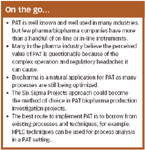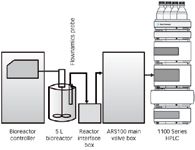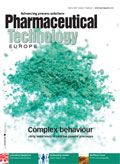News
Article
Pharmaceutical Technology Europe
Pharmaceutical Technology Europe
PAT: HPLC on the horizon?
Author(s):
PAT guidance has been available from FDA for more than 4 years, but there have been no apparent breakthroughs in large-scale upstream production. Will companies consider using on?line chromatography to change this?
The long awaited Guidance for Industry: PAT — A Framework for Innovative Pharmaceutical Development, Manufacturing and Quality Assurance was released by FDA in September 2004 as a nonbinding recommendation for pharmaceutical manufacturers. The driving force behind the document is the realization that the industry must improve product quality and production efficiency, drive down costs and provide effective treatment options at sustainable prices. The evident means to this end is to effect production automation and production analytical techniques in pharmaceutical production that are now routinely used to good advantage in other process industries.

(Thomas Northcut/Getty Images)
However, more than 4 years after its issuance, PAT implementation is still a work in progress with test installations, but no real breakthroughs in either pharma or biopharma largescale upstream production. Why?
It is well known that other industries, such as hydrocarbon processing, semiconductor manufacturing and food, have a long history in costefficient process analysis. Process spectroscopy, online or inline, for manufacturing in these industries is commonplace. By contrast, even the largest pharma/biopharma companies rarely have more than a handful of online or inline instruments used in their facilities, and most of those are used for monitoring environmental emissions rather than production.
So what is driving (or preventing) the pharma and biopharma industries from using on-line technology in production processes beyond simple, singlepoint, noninvasive spectroscopy techniques? Will they consider more capable techniques such as on-line chromatography to implement Quality by Design (QbD) in production?
Industry perceptions
A brief survey of on-line instrument users, conducted by Groton Biosystems (MA, USA) as part of its business planning process in 2003, yielded the general opinion that on-line instrumentation causes high instrument and project costs, complex operation and regulatory headaches. In other words, the perceived value of PAT is questionable. Specifically:
- instruments have a high initial purchase price
- operating costs are even higher than before
- project costs can be three times that of instrument costs
- instrumentation sensitivity is still not good enough
- calibration is difficult
- oneoffs are the rule and not the exception
- reliable physical interfaces to get access to the sample with processing equipment are difficult to achieve and maintain.
These reason explain the reluctance to move forward with PAT technology. However true these perceptions may have once been, there have now been many advances in modern PAT instrumentation.
Change for the sake of change?
Even as technology barriers to PAT are eliminated one-by-one, there will continue to be business and regulatory challenges to widespread PAT implementation in the industry; for example:
- Plant management is conservative. Plant managers and engineers do not want to modify manufacturing equipment unless it is absolutely necessary. However, most current PAT measurement equipment can be fit to process streams with minimal modification.
- In regulated pharma and biopharma, the substitute PAT measurement solution must be validated and qualified with a regulatory agency. To streamline the process and to accelerate 'buyin', FDA has incorporated 'safe harbour' and other inducements in PAT guidance. ICH guidelines are following suit.
- Software validation requirements hinder adoption as a large number of chemometric software applications are difficult to validate or do not meet a company's quality criteria. While this is true for many existing chemometric platforms, an alternate approach is to use existing wellqualified, easytovalidate and familiar software products to perform the appropriate level of data reduction. Often, data only need to be reduced to the same format and standard as that which is found in a typical laboratory assay and familiar to all users.
- Sophisticated process analytical instrumentation is difficult for plant operators to use. This is true, but modern graphic user interfaces simplify operation. Totally automated feedback loops will control the entire process with minimal intervention required.
- The European community's ATmosphères EXplosibles (ATEX) rating is important for plant floor installations. Most systems and instruments can easily meet ATEX or equivalent requirements with only moderate modification — most often through use of offtheshelf enclosures.
As technical and regulatory arguments against PAT implementation are successfully and positively addressed as the industry moves forward, the remaining arguments become financial. How does one make it work in the current and future economic climate?
What decision makers expect
Biopharmaceutical production is a growing area and a natural application for PAT as most processes are relatively new and many are still being optimized. Furthermore, most operating facilities are new because of ongoing expansion in capacity and are more easily automated. The entire biopharma process, beginning with feedstock quality control, through to the upstream process, downstream purification, lyophilization, formulation and ending with the final product test, has multiple opportunities to apply PAT sensors and statistical control processes. These may be as simple as singlepoint sensors or as sophisticated as full feedback control loops.
Each of the many steps and degrees of freedom in the entire process significantly affects the end product. Therefore, control of any step will improve the process and, consequently, control of the entire process through application of PAT tools will justify the investment.
Economic advantages of process automation can be seen be reviewing the history of successful, highly automated process industries. However, a number of issues must first be resolved to obtain wider acceptance and deployment of PAT in biopharma.
Hardware performance
• The pharmaceutical industry, in particular, seeks improvements with interfaces to process equipment and samples, reproducibility and calibration stability. Pharmaceutical companies are looking for rugged 'factory-ready' instruments with robust sources, alignment and calibration. PAT technology must comply and keep pace.
• Managers want simplified interfaces for updating the chemometric model and more standardized models, and compatibility with other equipment and software, such as in-plant control systems. Again, the technology must keep pace.
• The pharmaceutical industry expects sophisticated laboratory instruments to be tailored for PAT needs and used in place of custombuilt equipment. PAT would, therefore, be much cheaper than at present. Cost and value considerations are substantial barriers that must be overcome before PAT is widely used. This is a function of market volume and standardization, as well as adaptation to the production environment. In the pharma and biopharma industries, PAT will probably require more specific qualification guidance from FDA to develop standardized solutions. This is an ongoing objective.
System integration
• Most companies prefer to purchase instrumentation directly from instrument manufacturers, but will work with systems integrators (SIs) and other service providers on a projectbyproject basis as needed.
• Larger companies have resources — specialized teams at the corporate level and sometimes at plant level — that will broker a partnership with process control or process equipment manufacturers.
• Pharma companies are mostly interested in system integration help as they usually buy from instrument manufacturers and not SIs.
Operation, service and support
• Ease of use is important in all applications. These instruments have to be 'operator ready' — meaning they are easy to run, understand and maintain, with simplified internal diagnostics and expert system capability.
• Service and support is important for all industries as many have been disappointed with what is available so far.
• Most companies, especially those that have implemented solutions on their process lines in several geographies, generally want to have service and support globally rather than regionally.
• Pharma and biopharma would additionally like vendor help with qualification (operational qualification/performance verification).

On the go...
Making the appropriate choice
The industry is narrowing down the options to decide where to begin with PAT. Simultaneously, measurement solution suppliers are also making their choices in how to most effectively support their customers' workflow while achieving their short and longterm business goals by offering hardware, software, consulting and support.
As an example, the Six Sigma Projects approach, developed by Motorola, could become the preferred method in PAT biopharma production investigation projects. The goal of Six Sigma is to systematically identify the most important process step; that which creates the greatest variability in the overall process, via DMAIC:
- Define the scope of the project (i.e., the process step to be optimized).
- Measure the current process and certify that the information gathered relates to the scope of the project.
- Analyse the root causes and confirm with measured data.
- Improve the process step, test and implement changes that address the root cause, and use measured data to evaluate the solutions.
- Control will standardize processes, if so desired.
And then do it again. The overall goal of DMAIC is to understand and characterize the individual process steps, remove variability and then optimize the process. The need for measurement may be reduced in the long-run as the process can be predicted by chemometrics. During execution of the Six Sigma Process, a short-term positive side effect may result in identifying 'quick wins', which can be assessed and put into use without major changes. These modifications are reversible in case they do not achieve the expected results in the test cycle. In theory, this looks straightforward (which it is), yet questioning what to measure and how is a very important part of the equation.
It is important to remember that the goal is to implement PAT knowledge into existing production processes. Measurements that are too complex or too dependent on multicomponent calibration will tend to make things more complicated and less reliable. Often, the best route to implementing PAT technology is to borrow from existing laboratory processes and techniques. As an example, it is possible to use standard high performance liquid chromatography (HPLC) techniques for process analysis in a PAT setting. This offers a valid alternative because HPLC offers a wellsupported, wellunderstood and universally implemented platform from which a reliable PAT analytical process can be built. Not only is the process robust and reliable, but achieving buy-in from all levels — technical to financial to executive — should be simplified, as it is a well-known technology with decades of knowledge and experience to support it.
HPLC — PAT in practice
Today, a large number of process and qualityrelated measurements are performed by manually drawing a representative sample from the process, then separating and determining compounds by a chromatographic or electrophoretic method in a laboratory. This separation step is crucial in most assays because the complex sample matrix typical of modern pharma and biopharma processes defeats not only simple spectrometric assays, but often defeats the most sophisticated chemometric approaches. The process also takes time — from drawing the sample to reporting the result — such that the result is not reported in a timely manner, but it should be noted that the actual speed of analysis following delivery of sample to the analyst is, in most cases, not the limiting factor. HPLC, which has been the workhorse technology for many years, has recently undergone a metamorphosis to become a race horse such that analysis times in minutes are the rule, not the exception. PAT will never completely eliminate manual processes, but the advances in HPLC coupled to modern practices in online sampling now permit consideration of HPLC as a serious PAT tool.
One example of a successful HPLC PAT application is amino acid analysis (AAA). The goal of completely understanding the fermentation process (a core PAT philosophy) to produce monoclonal antibodies in Chinese Hamster Ovary (CHO) cells has lead to a revival of the well-known technique. Because of improved instrumentation and chromatographic separation, analysis is much faster today using proven straightforward chemistry. Realtime monitoring of the amino acid content in medium will ensure that these vital building blocks for protein will be maintained at optimum levels throughout the course of the process. In fact, it can be shown that realtime monitoring of amino acids in fermentation and cell processes can have a direct and positive impact on the outcome of the process, leading to higher yield and, in some cases, shortened process cycles.

Figure 1: Schematic of sample flow. The ARS-HPLC system automates this proven separation technique, while also providing a direct reactor sampling technology to completely automate the entire process.
For example, the ARS-HPLC system provides a hyphenated PAT solution to online PAT analysis of amino acids in a time frame relevant to the production process (Figure 1). This system was used to monitor amino acids through the course of a 14day CHO cell culture. It is common in most cell culture and fermentation processes to use defined media, with precise concentrations of amino acids added to the media mixture to maximize growth and maintain cell or organism health throughout the process cycle. Monitoring amino acid concentrations in real time can permit careful regulation of amino acids through feeding strategies to supplement those amino acids that are consumed in the production of proteins, peptides and other metabolic processes. Figure 2 demonstrates the results of this analysis at midpoint feeding. Chromatograms acquired before and after feeding display the depletion of certain amino acids prior to feeding, and the replenishment and restoration of typical concentrations of those amino acids because of feeding. Further analysis of this data can be used to determine optimum feeding strategies to improve product yield and reduce cycle time.

Figure 2: Sample overlays from day 7 of bioreactor run. Note: Only primary amino acids, detected at 338 nm, shown.
AAA is just one example. Gas chromatography/mass Spectrometry (GC/MS) is already an established technology used to investigate volatile organic compounds and is used in biotechnology to monitor fermentor headspace for gaseous products of metabolism. In the future, we may expect to see online applications for liquid chromatography (LC)/MS analysis of macromolecules, as well as small molecules including glycan profiling by LC/MS.
Outlook
The future of biopharma process development and production will depend on acceptance and widespread implementation of automated techniques that support the goals and philosophy of PAT practice as envisioned by FDA. The combination of data, information and knowledge, derived from extractive, as well as nonextractive testing, will be instrumental in developing and fine tuning chemometric models to support predictions implemented in full feedback and feed forward PAT installations.
The best PAT solution may well be online HPLC, or a combination of separation and spectroscopy. HPLC is a proven technology, versatile, easily adaptable, well understood, and widely used. Most processes need separation (HPLC), identification (HPLC and spectroscopy) and quantitation (HPLC and spectroscopy.) Online HPLC has a place in the future of PAT.
Acknowledgement
Marissa Braganza, Eddie Rustandi, YaoMing Huang, Michael Moloney of Biogen Idec (CA, USA) for authoring Agilent Technologies Application Note 5989-7240EN. J.W. Henderson and Cliff Woodward from Agilent Technologies. Robert Gauvin from Groton Biosystems.
Michael Kraft is Industry Marketing Manager Pharma/Biopharma Solutions at Agilent Technologies R&D and Marketing GmbH & Co. Kg (Germany).
George Barringer is from Groton Biosystems (USA).
Newsletter
Get the essential updates shaping the future of pharma manufacturing and compliance—subscribe today to Pharmaceutical Technology and never miss a breakthrough.






